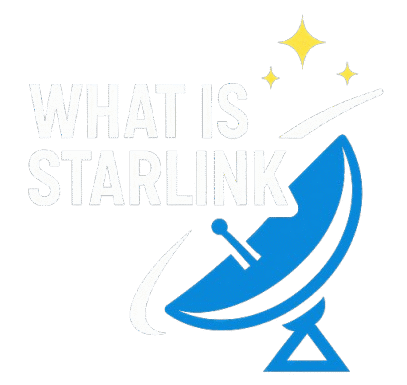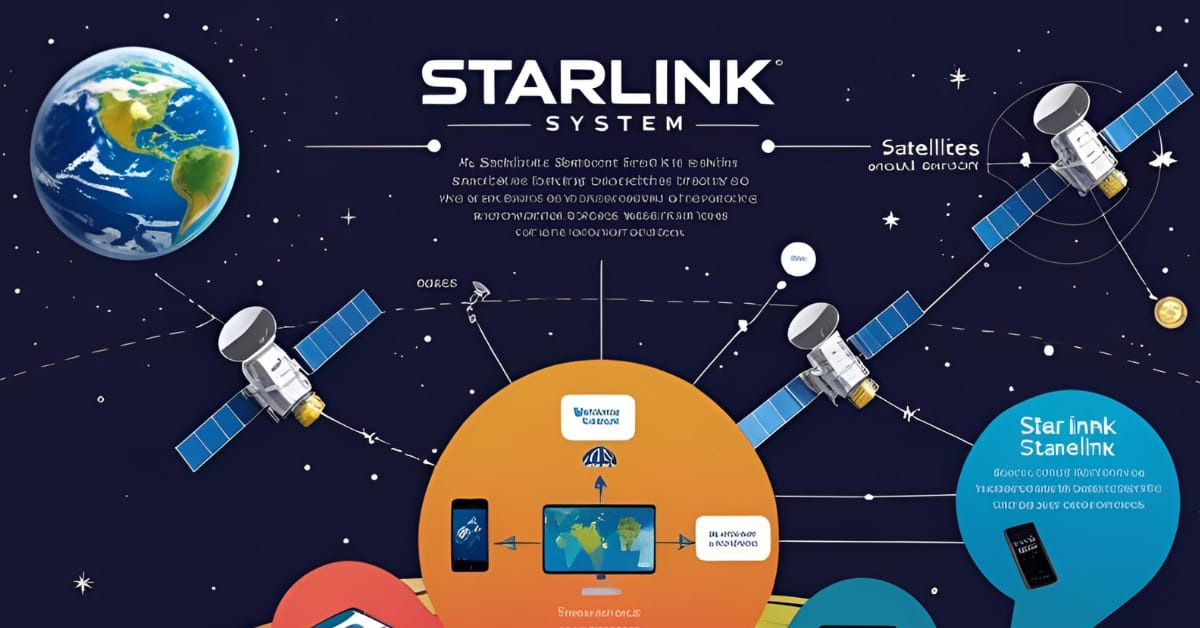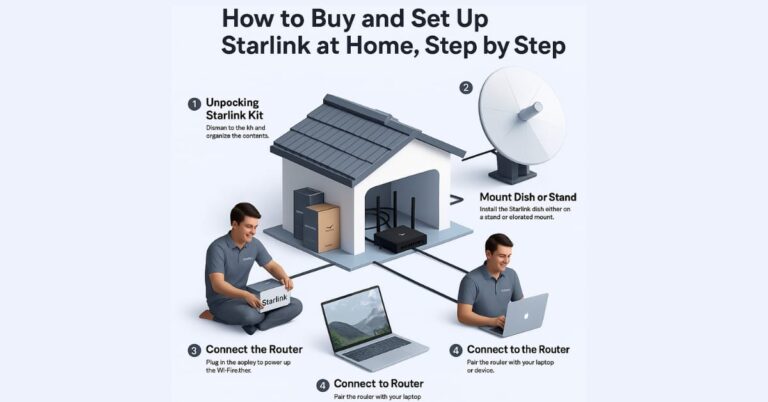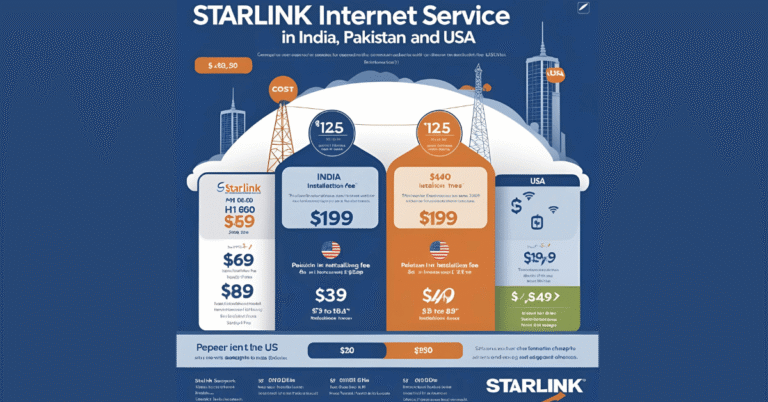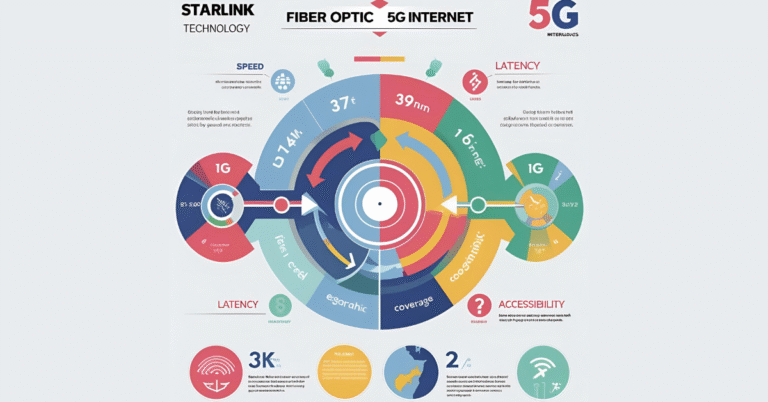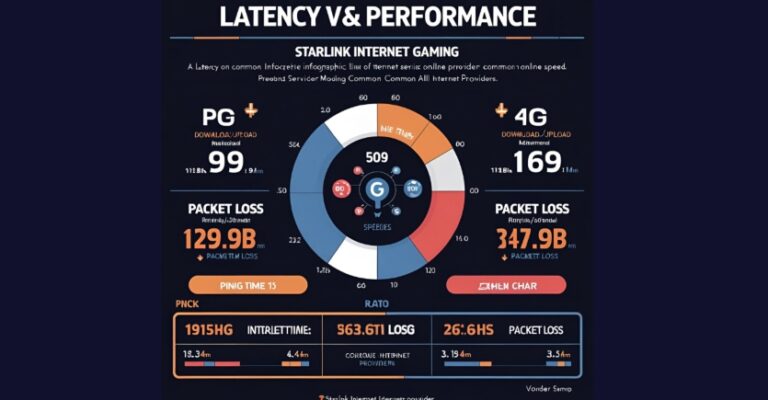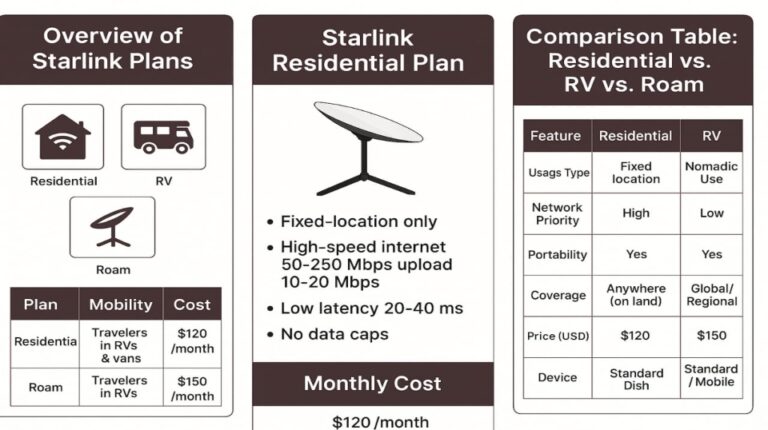How Does Starlink Work? Simple Explanation For Everyone
How does Starlink beam internet from space directly to your home? Starlink uses thousands of satellites to bring fast internet to cities and remote areas. It’s not science fiction—it’s real and happening now.
If you’re a student, a business owner, or someone living far from big cities, Starlink is changing how people worldwide connect to the internet.
This article covers Starlink’s technology, infrastructure, and functionality in simple, easy-to-understand language.
What is Starlink?
SpaceX started Starlink to provide internet through space satellites. Elon Musk founded the aerospace company.
Its goal is to provide high-speed, low-latency broadband internet service to underserved and remote regions worldwide. Traditional internet relies on cables and ground-based towers, but Starlink transmits data using satellites orbiting the Earth.
What makes Starlink unique?
Sheer scale of its satellite network. Instead of a few large satellites, Starlink uses thousands of small satellites that orbit close to Earth.
This strategy allows for faster communication and lower latency than conventional satellite internet.
How Starlink Differs from Traditional Internet Services
Traditional broadband relies on ground infrastructure—fibre-optic cables, cell towers, and telephone lines. These systems cost a lot and take time to set up, especially in remote or mountainous regions.
Starlink, on the other hand, operates entirely from space. It eliminates the need for on-the-ground infrastructure, making it useful for rural areas, disaster zones, and countries with limited connectivity.
It also reduces the “last-mile problem”—the challenge of connecting homes in hard-to-reach places.
What is the role of satellites in Starlink’s network?
This low Earth orbit allows Starlink satellites to transmit data faster and with lower latency. Since the signal doesn’t have to travel as far, it returns to Earth more quickly, improving gaming, video calls, and online streaming response times.
The heart of Starlink’s system lies in its massive constellation of satellites. These satellites orbit at altitudes of 340 to 1,200 kilometres—much lower than traditional satellites, which orbit around 35,786 kilometres.
How the Starlink Dish, Router, and App Work Together
To use Starlink internet, you need a Starlink Kit. It has three main parts:
- Dish
A dish is a round, flat plate that talks to the satellites in the sky and moves independently to get the best signal.
- Wi-Fi Router
This box lets your phones, computers, and TVs connect to the internet.
- Starlink App
This app helps you set everything up. It shows where the satellites are and helps fix problems.
The setup process is designed to be plug-and-play. Most users can get online within 30 minutes of installation.
How Data Travels Through Starlink’s Network
When you send an email. It works through Starlink:
Step-by-step guide
- Your device sends the data to the Starlink dish.
- The dish beams the data to a satellite passing overhead.
- The satellite transmits the data to a ground station connected to the global internet.
- The data then travels through the internet and reaches the recipient.
The process works in reverse for downloads or streaming. These steps happen milliseconds because of the low orbit and vast satellite network.
Why Low Earth Orbit (LEO) Matters
The closer a satellite is to Earth, the quicker it can send and receive data. Traditional geostationary satellites orbit at high altitudes and suffer from latency delays in data transmission. This can cause buffering, lag, and delays in communication.
LEO satellites, like those used by Starlink, minimise this issue. With a latency as low as 20-40 milliseconds, Starlink is comparable to or better than many DSL and cellular connections.
What is a Starlink Constellation
A “constellation” in satellite terms refers to a group of satellites working together to provide coverage. Starlink’s constellation consists of over 5,000 satellites (and counting) arranged in specific orbits to cover as much of the Earth’s surface as possible.
These satellites constantly move, and as one moves out of range, another moves into place. The user’s dish adjusts automatically to maintain a connection.
How Starlink Handles Network Traffic
Starlink can experience congestion like any internet service, especially during peak hours. However, the system uses intelligent routing and load balancing to manage traffic. The constellation’s redundancy means that if one satellite is busy or malfunctioning, others can take over.
SpaceX is also continuously launching more satellites to expand capacity and maintain performance as user demand grows.
Starlink’s Speed and Performance
Early reports from users indicate download speeds ranging from 50 Mbps to 250 Mbps, with upload speeds around 10 to 40 Mbps. Typically ranges from 20 to 40 milliseconds.
While these numbers may vary depending on location, weather, and satellite coverage, they are sufficient for most online activities, including 4K streaming, online gaming, video conferencing, and more.
Starlink’s Impact on Remote and Rural Communities
In many parts of the world, high-speed internet is still a luxury. Starlink is changing that by bringing reliable internet to villages, farms, deserts, and even forests. It enables remote work, online education, telemedicine, and digital banking, transforming lives and opening up new opportunities.
Starlink offers a lifeline for emergency services and disaster response teams when traditional networks are down.
Starlink vs 5G and Fibre Internet
- 5G offers high speeds but relies on dense networks of ground-based towers, which are often unavailable in rural areas.
- Fibre-optic connections provide excellent speed and stability but require expensive infrastructure installation.
Starlink provides a middle ground: decent speeds and wide coverage without local infrastructure. It doesn’t aim to replace fibre or 5G in cities but complements them by covering gaps.
What are the Limitations of Starlink
Despite its innovation, Starlink has limitations:
- Weather plays a role such as Heavy rain, snow, or obstructions, can affect performance.
- Cost: At first setup (around $599) and monthly service ($110–$135) can be expensive for some.
- Latency for Competitive Gaming: Though low, it may still not match fibre-optic latency for professional gamers.
- Space Traffic: Thousands of satellites raise concerns about space debris and collisions.
What is the Future of Starlink
Starlink plans to expand its network to tens of thousands of satellites.
Speed and reliability are expected to increase with continuous satellite design and software improvements.
Starlink is also testing laser inter-satellite links. These links help Satellites talk to each other without using ground stations. This makes the internet faster and better, with global performance, especially in remote regions.
How Businesses Use Starlink?
Who Else Uses Starlink
Starlink is not just for homes. Many others use it too:
- Aeroplanes use it so people can use Wi-Fi in the sky.
- Ships use it to stay connected on the ocean.
- Armies and helpers use it during emergencies.
- Schools and hospitals use it in places that don’t have good internet.
Starlink helps many people in many ways!
How to Get Starlink?
Ordering Starlink is simple. You visit the website, enter your address, and place an order.
The kit arrives in a box with simple instructions. Installation typically involves:
- Mounting the dish in a clear area
- Plugging in the router.
- Using the app to ensure proper alignment.
Within minutes, you can be connected to the internet via space.
Starlink’s Impact on Nature and People
Some Worries About Starlink
Some people are worried about Starlink:
- The satellites are bright, which makes it hard to see stars.
- Too many satellites could crash into each other in space.
- One company might control too much of the internet.
Starlink is trying to fix these problems. They make the satellites less shiny and help them safely return to Earth when they stop working.
What Makes Starlink Special
Starlink is a new way to get internet. It uses many small satellites that fly close to Earth. These satellites help people in faraway places go online.
People in small towns, moving homes, and places hit by storms can use Starlink. It helps more people get internet where wires can’t go.
Starlink still has some problems, but it’s getting better. One day, satellite internet could be as common as phone or fibre internet. Learning how Starlink works helps us see how it can change the world.
Common Questions About Starlink
It is not possible to remove the adverb. A1: Starlink is a satellite internet service from SpaceX. It uses an extensive network of small satellites in low Earth orbit (LEO). This setup offers fast, low-latency internet to users around the world. This is especially helpful in areas where traditional internet is unavailable or unreliable.
Q2: How is Starlink different from traditional satellite internet? A2: The main difference is the satellite’s orbit. Traditional satellite internet uses geostationary satellites that are far away. This distance leads to high latency. Starlink’s satellites are much closer, at about 550 km in LEO. This cuts down on latency and provides a faster internet experience. It’s great for online gaming and video calls.
Q3: What do I need to get Starlink? A3: You need to order a “Starlink Kit.” This kit usually has the Starlink Dish, also known as “Dishy,” a Wi-Fi router, and the required cables. You’ll also need a clear sky view to position your Dishy correctly.
Q4: Is Starlink available everywhere, including Pakistan? Starlink is expanding its coverage at a fast pace. It is available in over 99 countries, including Pakistan. Availability can change in those countries due to local rules and network capacity. You can check the Starlink website for availability at your address.
Q5: What kind of speeds can I expect with Starlink? A5: Starlink speeds vary by location, time of day, and network congestion. Speed and latency improve as we launch more satellites and grow the network.
Conclusion: A New Era of Global Connectivity
Starlink isn’t just an internet service. It shows our creativity and brings us closer to a connected world. SpaceX is closing the digital gap. They are doing this with a big satellite network in Low Earth Orbit and new tech. It brings high-speed, low-latency internet to areas where it was once a dream.
Starlink has challenges, but it’s growing quickly. New ideas suggest it will shape global connectivity for years to come. Starlink lights up the digital world. It links remote homes and schools in underserved areas. It hints at a future where geographic isolation does not mean digital exclusion. Is Starlink the right choice for you? Yes, for many people, especially those who need dependable internet beyond standard broadband.
